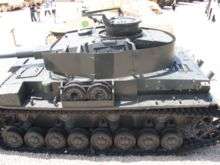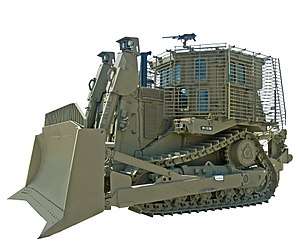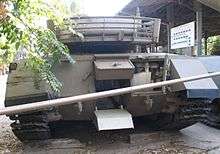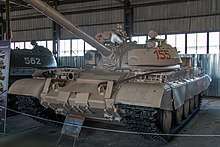Spaced armour
Armor with two or more plates spaced a distance apart falls under the category of spaced armour. Spaced armour can be sloped or unsloped. When sloped, it reduces the penetrating power of bullets and solid shot, as after penetrating each plate projectiles tend to tumble, deflect, deform, or disintegrate; spaced armor that is not sloped is generally designed to provide protection from explosive projectiles, which detonate before reaching the primary armor. Spaced armour is used on armoured military vehicles such as tanks and combat bulldozers. In a less common application, it is used in some spacecraft that use Whipple shields.



Against kinetic penetrators
The first spaced armors were used on iron (then steel) warships from mid 19th century. Between the thin outer armor of various less important parts and the thick main armor (protecting turrets, ammunition depots, boilers and turbines) were constructed storage spaces, coal or oil bunkers, and so on (Lord Nelson class). Some ships (e.g. Tirpitz, Takao, King George) had thicker outer and thinner inner layers in order to lower the damage caused by the penetrating round. From 1900 some cruisers and battleships built by modern spaced armor, where the outer thin layer of was intended only to damage the projectiles (e.g. Littorio class).[1]
Torpedo bulkheads also serve as a special form of spaced armor for naval vessels.
Tank spaced armour has been fielded since the First World War, when it was fitted to the French Schneider CA1 and Saint-Chamond tanks. The late variants of Panzer III had frontal spaced armour. A 20 mm thick face-hardened steel layer were in front of the 50 mm thick main armor. Impacted projectiles were physically damaged by the plate, so the main armor could withstand much greater hits. Due to lack of materials, German industry eventually switched to RHA, which is less effective and due to the slower production process, the technique was not widespread on German tanks.
It is important in designing of integral spaced armor that each layer should be thick enough to cause adequate damage to the projectile or jet. So the thickness of every layer should reach roughly the half of the diameter of projectile expected to impact.
Many World War II-era German tanks utilized armored skirts (Schürzen) to make their thinner side armor more resistant to anti-tank rifle fire. Contrary to popular belief the German Schürzen were designed against kinetic (AP, APBC, APCBC) projectiles.[2][3] The effectiveness of conventional AP projectiles was significantly reduced if they broke through a thin plate or dense wire net, because the projectiles become unstable in their trajectory and their tip would also be damaged. This method was very effective against contemporary light anti-tank weapons, like the Soviet PTRD-41 and M1937, the British 6-pounder, and the US 37mm guns.[4][5][6]
Some armored vehicles used nets of wooden logs in certain distance from the hull as makeshift spaced armour in order to protect the vehicle from magnetic mines, thrown shaped charges and grenades, and occasionally suicidal methods (e.g. Lunge mine). This method occurred on Sherman and T-34 vehicles, among others.
Against High Explosive Anti Tank rounds
Most of Cold war spaced armors designed against medium-to-low caliber kinetic munitions, (e.g. 30mm autocannon and 76mm HESH rounds), especially vehicle side skirts. Most of them made of RHA plates (Centurion), or thick reinforced rubbers (T-72), and worked in the same way of WW2-era ones.
This light armour also detonates explosive warheads prematurely. High Explosive Anti Tank-type warheads (HEAT) use a focused jet of super heated copper or steel to penetrate armour. To be effective, HEAT warheads must detonate at a specific distance from the target's primary armour to ensure maximum penetration. Thus early detonation greatly reduces the penetration of HEAT ammunition. This requires a distance of 1.2 meters even for an early 100mm projectile, thus conventional skirts are effective against HEAT only at very low angle of incidence.[4]
The use of add-on spaced armour skirts can sometimes have the opposite effect and increase the penetration of some shaped charge warheads. Due to constraints in the length of projectiles, some designs intentionally detonate closer than the optimum distance. In such cases, the skirting effectively increases the distance between the armor and the target, and the warhead detonates closer to its optimum stand-off.[7]
To increase effectiveness of skirts against HEAT weapons some mid-cold-war tanks (early T-64) had gill-style armor. It contained a few short skirts on the side of the vehicle which are opened in open terrain at an angle of 30-45° increasing the space between the armor and the plate. It was effective (mass-to-efficiency ratio), but easily detached from the vehicle so it did not spread widely.
A special version of reactive spaced armor is slat armor. It uses the own power of the impacting projectile (RPG, ATGM) to destroy it. Steel slats placed at a specified distances have a 50-60% chance of breaking the RPG-7's warhead so no cumulative beam can be formed. It also provides some protection against thrown grenades.

In response to increasingly effective HEAT, HESH and APFSDS warheads, integral spaced armour was reintroduced in the 1960s on the German Leopard 1 and later the Merkava. Hollow spaces between plates allow increase the distance a projectile must travel to reach the interior of a vehicle. Sometimes the interior surfaces of these hollow cavities are sloped, presenting angles to the anticipated path of the shaped charge's jet or kinetic penetrator to further dissipate their power. The two (or more) layered spaced RHA armors were highly effective against early steel and tungsten APFSDS munitions, because the rod was severely damaged by penetrating the first layer and was thus ineffective on the inner armor. Therefore, a much thinner total steel thickness and weight was enough against a specific projectile. For example, a given weight of armour can be distributed in 2 layers 15 cm (6 in) thick instead of a single 30 cm (12 in) layer, giving much better protection against HESH and APDS munitions, but their effect on shaped charges was limited.[8] So military researchers tried to increase the efficiency of spaced armour by changing the used materials and increasing the number of layers, from the early sixties.
Composite spaced armours
Multilayer spaced armors, which also uses special materials, are transition to composite armor, most of the latter are also partially spaced armor.

In case of Leopard1A3 and later variants the outer layer of spaced armor was hardened steel and the space was filled by elastomer, thus the effectiveness of shattering effect of the outer layer against APFSDS were outstanding, and the protection against early HEAT warheads were increased too. The BDD add-on armor of T-55 and T-62 series based on the same effect, but it had multiple layers within elastomer, therefore it roughly doubled the frontal protection of these tanks against APDS and HEAT weapons, and make the areas of add-on immune against HESH rounds.[9] In T-64 and early T-72 (up to T-72M1) and T-80 (to mid T-80A) used stakloplastika (a special military-grade dense glass-fiber reinforced pressured plastic) as filling in the frontal upper glacis spaced armor. This plastic was effective in lowering the concentration of the jet of shaped charges and in destabilizing kinetic penetrators.[10]
Hardened steel plates has become commonplace for outer part of spaced armors from '80s not only on tanks but also on APCs and IFVs. With these add-on armors even the APC's thin armor is sufficient against kinetic bullets of 12.7 (Stryker and BTR-80 upgrades) and 14.5 calibers (Bradley, BMP-3) and also provides some protection against IEDs.
The increase of the number of layers in spaced armor increases the physical damage and destabilization of jets and kinetic penetrators, so it is common in more modern armor to use successive layers alternating between softer (air, aluminum or plastic) and harder (RHA, SHS) layers. With multiple layers the likelihood of bounce in case of kinetic projectiles is also increasing, and SC jets loss from their material when come through between layers with different density and their performance lowered due to the effects pressure and velocity changes (foreshortening) on their concentration. Thus later T-72B and T-90 armors used 7 layered spaced armor (with hardened steel plates) in order to achieve much stronger protection in cost of minimum weight increase.
The more advanced late cold war tanks were given multi-layer skirts (Leopard 2), in which passive (or reactive) effects significantly reduced the effectiveness of HEAT ammunition. At the same time, these elements are already heavy and have considerable thickness, which increase the size and weight of the vehicle and make maintenance difficult. Russian and some western tanks carries explosive-reactive armor blocks in order to increase effectiveness of spaced armors (particularly in case of side skirts, e.g. TUSK, T-90), and main frontal armor.[9][11]
Almost all of modern western and Japanese and most of soviet tanks use some kind of spaced armors on fronts and sides. Side panels of superstructure usually contain fuel, batteries (Leopard 2, Type 10) and other less vital elements or munition of secondary weapons (Merkava), because they also reduce the effectiveness of penetrating projectiles. In most important areas (frontal armor and sides of turret) the cavity of spaced armor contain composite panels. From 80's most of western tanks has composite armor blocks on the frontal part of skirts made of hardened steel or NERA armor (non-explosive-reactive armor, known as Burlinghton armor). Most of modern MBTs (e.g. T-72B, Leopard 2, M1, Type 10, K2, T-90, Type96) have NERA armor in their spaced armors which supplemented with inner ceramic armor and spall liners in some cases. In contrast, Soviet tanks were initially made with ceramic (corundum or silicate) inserts (T-64A, T-72A, T-72M1, T-80) and NERA-style inserts have spread in the upgraded versions of their vehicles later (T-72B, T-80A, T-72BU).[10][12][11][13] More detail in composite armour.
Nowadays composite spaced armors with hardened steel outer layer (often filled with NERA or ceramic inserts) are becoming more common on most advanced light battle tanks (ZTQ-15) and IFVs (Namer, Puma).[14][15]
Materials
As designs became more specialized, more and more materials were used. the most important are:
Elastomers
Some modern main battle tanks and IFVs carry rubber or steel (hardened in some cases) skirts to protect their relatively fragile suspension and lower side armor and lower glacis, often combining the two. Some elastomer fillings (e.g. M551's floating cells and screens, T-72B's radiation protection layer) behave like spaced armor, where the elastic layer effectively lowers the concentration of the jet of HEAT warheads. Leopard 1A3 and 1A4 and add-on armors of T-55 and T-62 used dense polystyrene filling in order to increasing the effectiveness of spaced armors. The early second generation Russian MBTs used dense glass-fiber reinforced pressured plastic as filling in the frontal upper glacis spaced armor which is even more effective than the pure elastomer.
NERA armors also use elastomers pressed between two or three sheets steel or aluminium layers, it acts as ERA armors with lesser effectiveness, but is not destroyed during operation, so it can hold multiple hits in same place. Most of modern MBTs use some NERA layer within their spaced armour, or as outer layer.[13]
Hardened steel
Whereas normal armour must compromise between hardness and ductility, spaced armour can be constructed from plates with differing material properties to increase effectiveness against kinetic energy penetrators. Most of Cold war and modern spaced armors use rolled homogeneous armor as inner and a thin (10-30mm) face-hardened, semi-hardened steel plate as outer layer. The thin, but very hard outer layer acts as burster and shatter plate which allow to design main armor much thinner with the same protection level The most advanced designs use triple- or high-hardened steels. In some cases aluminium is added to hardened steel armor as softer inter-layer in order to destabilising the projectiles and HEAT jets by density changes.
The Leopard 2 utilizes a slanted first armour stage (disturber), a specially hardened second stage (disrupter) and a softer, high ductility third stage (absorber). The disturber is designed to either entirely deflect or manipulate the direction of incoming kinetic energy penetrators. If penetration does occur, the projectile is then shattered and fragmented when striking the disrupter. Assuming the first two stages work properly, the absorber stage captures spalling and fragments.
Others
Some AFS uses the cavity of spaced armor as fuel tank, storage space, and warships used them as coal or oil bunkers, and rooms for non-vital components (e.g. washing rooms, food storages). These materials filling spaces could further slow down the penetrating projectile, increasing the protection. Modern AFVs spaced armors contain special fillings forming composite armors.
Spacecraft
The Whipple shield uses the principle of spaced armour to protect spacecraft from the impacts of very fast micrometeoroids. The impact with the first wall melts or breaks up the incoming particle, causing fragments to be spread over a wider area when striking the subsequent walls.
References
- "Bismarck Armour Protection". www.kbismarck.com. Retrieved 2019-08-27.
- Thomas, Steven (2003-07-16), Why were Schürzen introduced in WW2?
- Hughes, Matthew (2000), The Panther Tank, Staplehurst: Spellmount, p. 30, ISBN 978-1-86227-072-5
- Chamberlain, Peter (1974). Anti-tank weapons. Arco. ISBN 0668036079.
- "The ptrs and ptrd russian anti-tank rifles". Warfare History Network. 2016-11-04.
- Bonhardt, Attila (ed.) (1992). A Magyar Királyi Honvédség fegyverzete (in Hungarian). Zrínyi. ISBN 9633271827.CS1 maint: extra text: authors list (link)
- WILEY-VCH Verlag GmbH, D-69451 Weinheim (1999) - Propellants, Explosives, Pyrotechnics 24 - Effectiveness Factors for Explosive Reactive Armour Systems - page 71
- Kaufmann; et al. (2004). "Ballistic Performance of Monoblock and Jacketed Medium-Caliber Penetrators against Composite Armor and Spaced Targets" (PDF). Armor and Impactor Studies.
- Warford, James (2002). "Ilich's Eyebrows" (PDF). Armor. 2: 30–31.
- "Основной боевой танк Т-80У "Объект 219АС"". btvt.narod.ru. Retrieved 2019-08-27.
- "Leopard-2A0-A4 armor protection estimation". www.btvt.narod.ru. Retrieved 2019-08-27.
- Tankandafvnews (2016-02-23). "From the Vault: Chieftain Articles and Documents". Tank and AFV News. Retrieved 2019-08-27.
- Sukumar, G. (2017). "Future Armour Materials and Technologies for Combat Platforms". Defence Science Journal. 67 (4): 412. doi:10.14429/dsj.67.11468.
- "ZTQ Light Tank". www.globalsecurity.org. Retrieved 2019-08-27.
- "Puma AIFV Tracked Armoured Infantry Fighting Vehicle". Army Technology. Retrieved 2019-08-27.